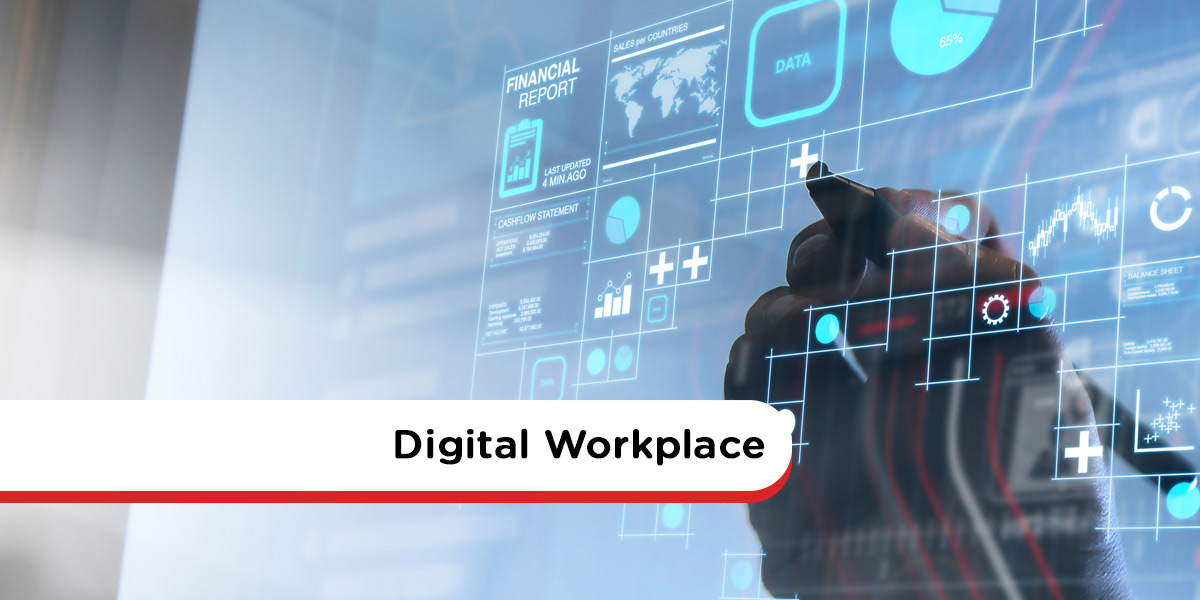
Your New Intranet Starts Here
Streamline communication, boost collaboration, and empower your team with MyHub's intuitive intranet solution.
Book a live demo now and experience the difference.
Take a Quick TourFirst coined by DWG in 2009, the term digital workplace was once new and exciting. Back then, organizations were cautiously embracing the cloud, setting up intranets, and experimenting with emerging tools like Yammer. Fast forward several years – and one pandemic later – the landscape has dramatically changed. Nowadays, virtually every organization has some form of a digital workplace. But while the term is now part of everyday business language, it’s still widely misunderstood. Many executives think it’s just a collection of apps; others assume it’s only relevant for remote working.
This ultimate guide clears up the confusion by exploring exactly what the digital workplace means today. We’ll answer your key questions, including:
- What is a digital workplace?
- Why do businesses need it?
- What are the benefits for employees and organizations?
- How do you build a successful digital workplace strategy?
So, keep reading if you want to ensure your organization’s digital workplace aligns with modern best practices.
What Is A Digital Workplace?
The simplest way to understand it is this:
The digital workplace is the online equivalent of your physical office. It’s a centralized ecosystem of tools, data, and apps that employees use to complete their work efficiently – anywhere, anytime, and on any device.
Standard features of a digital workplace include:
- Single sign-on and gateway access
- Collaboration tools for teams
- Business instant messaging and communication platforms
- Cloud storage for seamless access
- Knowledge management systems
- Document sharing and version control
- Automated workflows to boost productivity
- Project management tools for tracking progress
- Mobile integration for flexible working
- Business applications such as CRM, ERP, and CAD
- And much more, tailored to meet organizational needs
Hybrid Working: Why We Need The Digital Workplace
The pandemic significantly accelerated the global shift toward digital transformation. According to Deloitte, COVID-19 sped up digital adoption by five to ten years. While the early stages of remote working were challenging, many organizations have now successfully adapted to the new normal.
This is crucial, as remote work is here to stay. Research from Forrester suggests that working from home will increase by 300% compared to pre-pandemic levels.
In fact, it’s a clear preference for many employees. The growing demand for flexibility has solidified hybrid working as the standard model. The Microsoft Work Trend Index supports this, revealing that 66% of employers are developing formal hybrid work arrangements.
The way we work has changed forever. With more organizations supporting distributed workforces, essential job functions, such as collaboration and communication, now occur online.
As the physical office is no longer the central hub, digital touchpoints have become crucial. They help employees remain connected, productive, and engaged in their roles.
The responsibility lies with employers to create a seamless and secure digital experience. Prioritizing data security, fast access, and user-friendly software is essential to support a thriving digital workplace environment.
Key Benefits Of A Digital Workplace For Employees And Organizations
The advantages of implementing a digital workplace extend far beyond initial expectations. Businesses are discovering both expected and surprising productivity and engagement benefits. Here are some of the most impactful outcomes:
- Team Collaboration: Enhanced problem-solving, real-time interaction, and effective knowledge sharing contribute to stronger team collaboration and innovation.
- Flexible Working: Enables employees to work remotely or in a hybrid model, offering greater work-life balance and flexibility.
- Productivity Boost: Better communication and digital processes lead to increased employee productivity and faster task completion.
- Innovation: Inclusive communication channels empower employees at all levels to contribute ideas, fueling business innovation.
- Improved Transparency: Greater visibility across teams and processes reduces errors and increases accountability.
- Hidden Savings: Lower operational costs by reducing commuting, office space, and overhead expenses.
- Employee Experience: A more connected and inclusive experience that integrates task management with employee well-being.
- Retain Talent: Organizations offering flexible digital work environments enjoy lower turnover rates and improved retention.
- Enhanced Customer Experience: Empower frontline workers with tools to resolve customer issues efficiently and accurately.
- Knowledge Management: Seamless systems to capture, store, and share institutional knowledge and expertise.
- Increased Efficiency: Centralized platforms reduce time wasted switching between apps and searching for data – boosting overall productivity.
What Are The Essential Components Of A Digital Workplace?
Building a successful digital workplace requires a strategic focus on three core components:
- People
- Tools
- Culture
Each of these elements plays an essential role. When aligned, they create a workplace that drives digital transformation and enhances organizational performance.
People
Your people are the driving force behind the digital workplace. However, a growing digital skills gap is holding many back. The Global Digital Skills Index revealed that nearly 75% of workers feel underprepared for current digital demands, and 76% feel ill-equipped for the future.
Rather than adopting technology for its own sake, organizations must align digital tools with actual employee needs. The focus should be on delivering the right tools to the right people at the right time.
Investing in ongoing training and digital upskilling is essential. According to Salesforce and RAND Europe, failure to bridge the digital skills gap could result in G20 countries missing out on up to $1.5 trillion in GDP growth.
Tools
Most companies have initiated some form of digital transformation. In fact, only 23% of businesses report having no digital tools or platforms in place.
However, many suffer from a lack of integration and vision. A staggering 75% of executives believe internal teams are competing, rather than collaborating, on digital efforts.
A clear, unified digital workplace strategy ensures toolsets are tailored to support both employee workflows and business goals. This enables organizations to create a cohesive, scalable tech ecosystem.
Culture
Company culture defines how people work. Whether employees are working remotely, hybrid, or onsite, the digital workplace should provide a consistent and equitable experience.
Organizations that nurture a positive, inclusive culture – and embrace flexibility – are better positioned to attract and retain talent. Your digital systems should facilitate sharing, collaboration, and ongoing employee engagement.
The data supports this: employees empowered by technology are 230% more engaged and 85% more likely to remain with the company for three or more years.
Tips For Creating A Digital Workplace
Here are some practical tips to help you get started. Use these to blend your existing apps with new technology to create the ultimate user experience and a high-performing digital environment.
- Involve The Right People To Steer The Project: Senior ownership is crucial, but so is including team members who will drive the implementation of the new technology. While the C-suite may initiate the transformation, companies are 1.6 times more likely to succeed when a Chief Digital Officer is actively involved.
- Ensure Alignment With Business Strategy: Keep your business goals in mind. Every new tool or platform should be evaluated based on how it supports your long-term vision and how it will empower your workforce to succeed.
- Consider Internal Culture: How adaptable are your employees to digital transformation? Launch a proactive internal communications program that highlights the benefits of digital tools, making the transition smoother and more meaningful for your staff.
- Deliver Business Value: Avoid implementing technology just for the sake of novelty. Stay focused on solutions that drive real business outcomes and are aligned with measurable goals.
- Research Technologies: Use product demos, real-world case studies, or user testimonials to assess new tools. The digital market is fast-moving – select technologies that fit your specific business needs and offer scalability and integration.
- Consider Risk, Compliance, and Legal Consequences: Be aware of data security regulations and compliance obligations. Your digital workplace should be compliant with laws like GDPR, and ensure robust cybersecurity practices are in place.
- Develop A Roadmap: Build a strategic implementation roadmap. Define clear goals, assign responsibilities, set deadlines, and track your KPIs (key performance indicators) to measure success over time.
Digital Workplace Challenges
As with any organizational shift, there are challenges to overcome. Here are the most common issues faced during digital workplace transformation.
Employee Resistance
According to McKinsey, 70% of digital transformations fail due to employee resistance. The digital skills gap exacerbates this issue. Employers must clearly communicate the benefits of digital workplaces and provide comprehensive training and upskilling programs to engage employees in the transition process.
Security
With data breaches making frequent headlines, cybersecurity is a top concern. A survey of C-suite executives revealed that 82% had experienced at least one breach due to digital transformation. Security risks increase further when employees use their own devices. A successful digital workplace must include strong security protocols and employee awareness training.
Distractions And Productivity
Remote and hybrid work environments come with challenges like distractions and feelings of isolation. According to Gensler, 50% of Gen Z and Millennials report difficulty staying focused while working from home. However, other research shows that 77% of remote workers are actually more productive. Organizations need to monitor and support productivity through smart digital management tools and a human-centric approach.
Digital Workplace: Future Trends
What will the digital workplace of the future look like when artificial intelligence becomes mainstream and today’s grads lead tomorrow’s businesses? Here’s what to expect:
- Cloud-based Solutions: Robust cloud services will be essential for enabling seamless access and supporting hybrid work models.
- No Standing Still: Technology evolution will be constant. Businesses must be agile and open to continuous innovation and adaptation.
- All-On Automation: Traditional workflows will be replaced by automated processes, improving speed and accuracy across departments.
- Tech Choice Matters: The technology stack you choose will influence employee satisfaction and long-term system compatibility.
- Staff Expectations: Digital-native employees expect modern, collaborative tools. Businesses must meet rising employee tech expectations to stay competitive in talent retention.
- Customer Self-Service: Increasingly, customers will prefer self-service options, solving their issues via AI or FAQs without human interaction.
- Overwhelming Options: The explosion of SaaS tools can lead to platform fatigue. Integrations and interoperability will be key to success.
- Employee Experience: Organizations will invest more in tools that support employee engagement, satisfaction, and well-being to reduce turnover.
Digital Workplaces Are Here To Stay
The pandemic only accelerated a trend that was already in motion: the rise of the digital workplace. Done right, digital workplaces increase agility, flexibility, and productivity – a win-win for both employers and employees. But successful transformation requires employee buy-in and careful planning.
Ready to build your digital workplace? Talk to the expert team at MyHub. Our intuitive and beautifully designed cloud intranets power hybrid working across the globe. Explore the benefits with a free demo or 14-day trial today.
FAQ Section
What exactly does a digital workplace include?
A digital workplace integrates systems like content management, communication tools (chat, video), KPI dashboards, HR portals, and automation—all accessible via a unified, cloud-based platform.
How does a digital workplace improve productivity?
By centralizing resources and automating routine tasks, teams spend less time searching for information or running manual processes and more time on meaningful, strategic work.
What are the main challenges in deploying a digital workplace?
Typical challenges include employee resistance to change, the need for proper training and support, and ensuring security and governance across integrated systems.



